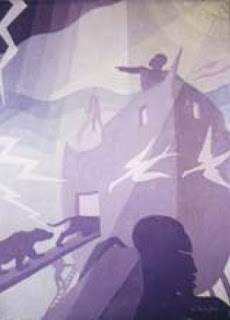Smithsonian American Art Museum Presents the First Major Retrospective of African American Modernist Aaron Douglas
“Aaron Douglas: African American Modernist,” on view at the Smithsonian American Art Museum May 9 through Aug. 3, presents the first nationally touring retrospective of Aaron Douglas (1899–1979), one of the most influential visual artists of the Harlem Renaissance. Douglas vividly captured the spirit of his time and established a new black aesthetic and vision. Preview Images and Captions (Adobe Acrobat PDF file, 73K)
Douglas’ forceful ideas about social change and distinctive artistic forms produced a powerful visual legacy through paintings, murals and illustrations for books and progressive journals and made a lasting impact on American modernism.
Douglas combined angular cubist rhythms and a seductive Art Deco dynamism with traditional African and African American imagery to develop a radically new visual vocabulary. His distinctive style with silhouetted forms and fractured space expressed both the harsh realities of African American life and hope for a better future.
Some of the artist’s most important works were mural commissions. He received his first major commission in 1930 for a series of murals for the new library at Fisk University in Nashville, Tenn. He chose subjects that he hoped would promote black identity and a sense of dignity among the students. In 1934, he was commissioned by the Public Works of Art Project to create a mural at the 135th Street branch of the New York Public Library. The four panels of “Aspects of Negro Life” reveal the bold modernist risks Douglas was willing to take when regionalism was the norm. His unique visual style, which drew from African, cubist and constructivist motifs, presented an allegorical representation of issues central to African American history and contemporary life.
“Aaron Douglas’ legacy is not only the body of work he left for future generations of artists and scholars to study,” said Mecklenburg. “His belief that artistic expression could be a bridge between African American and white culture, his courage to promote social change and his dedication to education truly make him ‘the father of black American art.’”
Born to laborer parents in Topeka, Kan., Douglas (1899–1979) overcame many obstacles to pursue his passion for art and ideas. After earning a bachelor’s degree in fine arts from the University of Nebraska in 1922, Douglas taught art at Lincoln High School in Kansas City, Mo. In 1925, he decided to move to New York City, inspired in part by an article in the magazine Survey Graphic, titled “Harlem: Mecca of the New Negro,” to join the flourishing cultural scene known as the Harlem Renaissance. During this exciting period, he met Alain Locke, a literary critic and philosopher who is considered the architect of the Harlem Renaissance; writer Zora Neale Hurston; photographer Carl Van Vechten; and prominent intellectual leader and activist W. E. B. Du Bois. He was a frequent contributor in the 1920s to the National Urban League’s journal Opportunity and to the NAACP’s journal the Crisis. Noted writers, such as Countee Cullen and Langston Hughes, collaborated with Douglas. In 1935, Douglas, who was politically active, became the first president of the Harlem Artists Guild. In 1938, he returned to Fisk as an assistant professor and began teaching full time in 1940. He received a master’s degree in art from the Teachers College at Columbia University in 1944. Douglas continued to teach at Fisk until his retirement in 1966. He died in 1979.
A major symposium was scheduled for Friday, May 9, from 1 to 5 p.m. Participating scholars were Richard Powell, professor of art and art history at Duke University; Amy Kirschke, associate professor of art history at the University of North Carolina, Wilmington; Renée Ater, assistant professor at the University of Maryland; and Earle. Kinshasha Holman Conwill, deputy director of the Smithsonian’s National Museum of African American History and Culture, will moderate, and University of Maryland Professor Emeritus David Driskell will deliver the keynote address.
A wide array of free public programs is being offered at the museum in conjunction with the exhibition, including gallery talks, films, performances, family programs and lectures. Details and complete program descriptions are available online at americanart.si.edu and in a separate press release.
A major monograph on Douglas accompanies the exhibition with an introduction by Conwill; essays by a number of prominent scholars, including Ater, Driskell, Earle, Kirscheke and Powell; and a chronology of Douglas’ life. It is available for $45 (softcover) in the museum store.
The final venue for the national tour is the Schomburg Center for Research in Black Culture in New York City (Aug. 30 – Nov. 30).
“Aaron Douglas: African American Modernist” was organized by the Spencer Museum of Art at the University of Kansas in Lawrence. The exhibition and accompanying catalog are made possible, in part, with support from the Henry Luce Foundation and the National Endowment for the Arts. The Diane and Norman Bernstein Foundation Inc. and PEPCO are proud to partner with the Smithsonian American Art Museum on the exhibition in Washington, D.C.
The Smithsonian American Art Museum celebrates the vision and creativity of Americans with approximately 41,000 artworks in all media spanning more than three centuries. Its National Historic Landmark building, a dazzling showcase for American art and portraiture, is located at Eighth and F streets N.W. in the heart of a revitalized downtown arts district. Museum hours are 11:30 a.m. to 7 p.m. daily, except Dec. 25. Admission is free. Metrorail station: Gallery Place/Chinatown (Red, Yellow and Green lines). Smithsonian Information: (202) 633-1000; (202) 633-5285 (TTY). Museum information (recorded): (202) 633-7970. Web site: americanart.si.edu. # # #
Note to editors: Selected high-resolution images for publicity only may be downloaded from ftp://saam-press@ftp.si.edu. Call (202) 633-8530 for the password. Additional information about the exhibition is available from the museum’s online press room at americanart.si.edu/press.
Media only: Laura Baptiste (202) 633-8494, Amy Hutchins (202) 633-8497 Media Web site: americanart.si.edu/press


















No comments:
Post a Comment